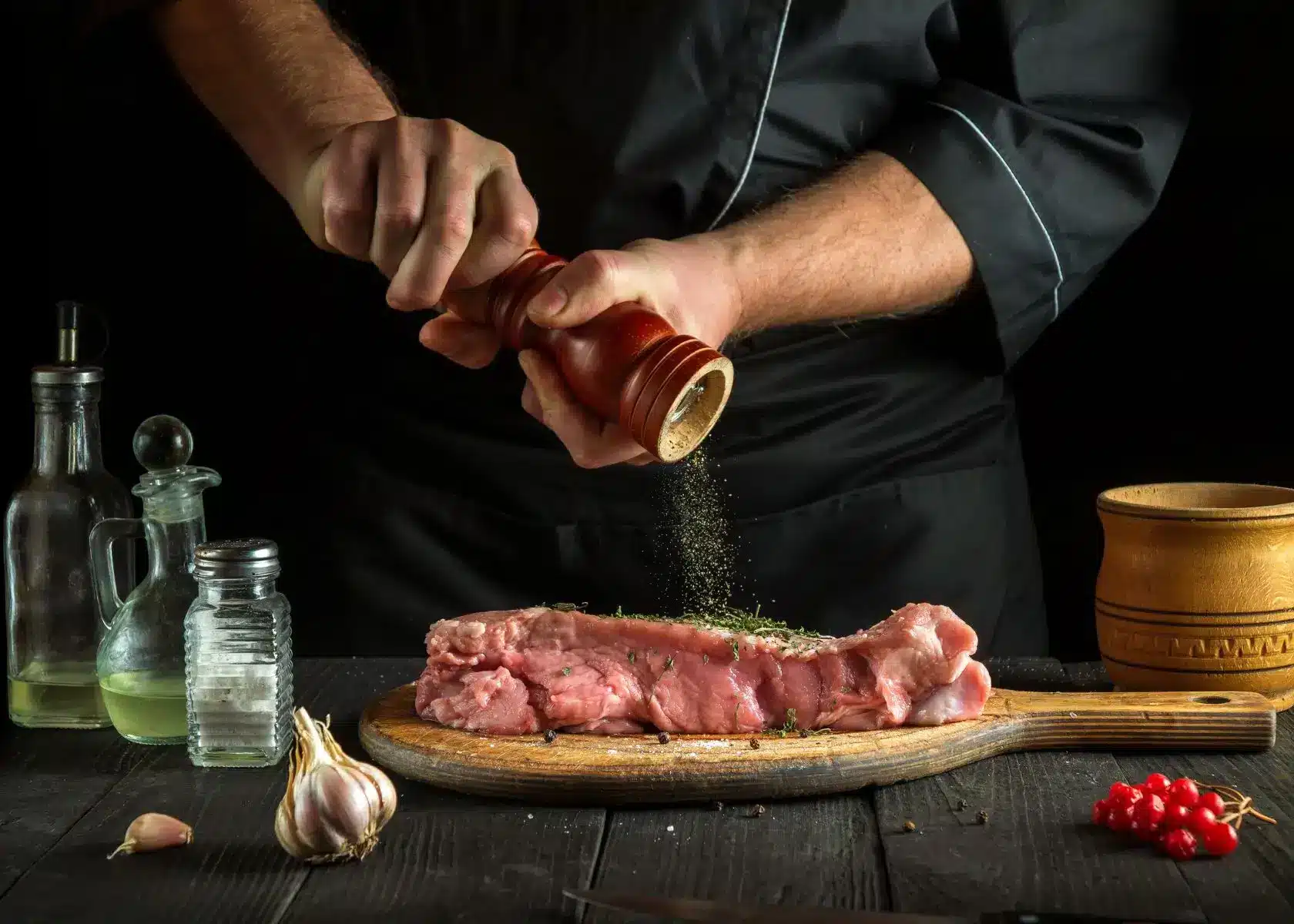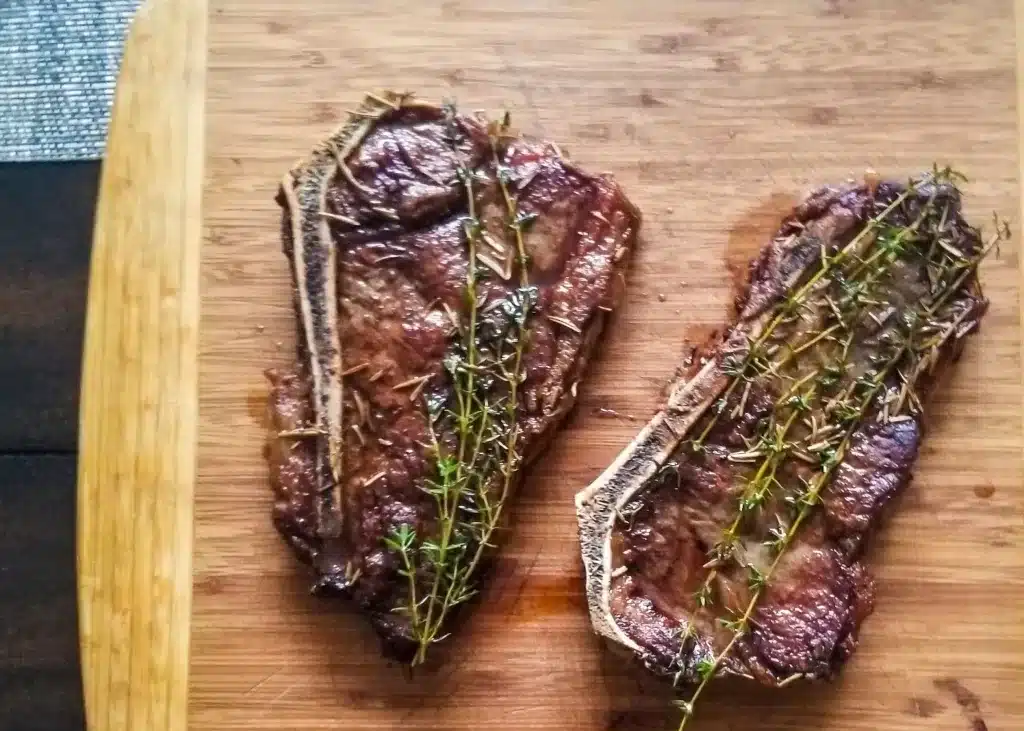Steak enthusiasts can celebrate with joy, as the act of letting a steak rest before cutting and enjoying it is considered an element in creating a memorable dining experience.
Mastering the art of cooking involves more than techniques and seasonings; giving your steak ample time to rest is key to enhancing its taste and texture to a whole new level.
Let’s delve into the aspects of letting steak rest properly in this detailed guide and discover the perfect resting durations along with valuable insights from experts to guarantee that you consistently dish out delectable steaks that rival those from upscale restaurants every single time.
Resting meat might sound odd initially. Why would you leave a cooked steak untouched when your taste buds are yearning for that first delicious bite?
The secret can be found in the art of cooking meat properly. When you grill a steak at high temperatures, the proteins in the meat shrink and release moisture. If you cut the steak away after cooking, all those delicious juices will run out, leading to a dry and less tasty piece of meat.
Giving the steak time to settle down after cooking just right for a bit longer than usual ensures that the flavors and tenderness reach their best potential in every mouthful you take, bite after bite of this delicious meal.
Exploring the concept of allowing steak to rest after cooking
The duration for letting a steak rest can differ based on factors like the type of cut chosen and its thickness, along with the cooking technique employed in preparing it. The general guideline suggests that thicker steaks need a resting period since they retain more heat and require sufficient time for the internal temperature to even out.
For cuts like skirt or flank steak pieces, it’s usually good to let them rest for about 5 to 10 minutes. Medium-thickness steaks, such as ribeyes or strip steaks, may need a resting time of around 10 to 15 minutes. As for thicker and heartier cuts, like a tomahawk or cowboy steaks, it’s best to give them a rest of about 15 to 20 minutes.
Keep in mind that the recommended resting times are suggestions; the actual duration might differ based on how you like to cook and your personal preferences. Some cooks insist that letting steaks rest for up to 30 minutes is key for flavor and tenderness; however, others opt for a shorter resting time to ensure the steak stays hot when served.
Preparing for the Perfect Rest
When you’re about to cook a steak at home, you might face a dilemma from the start. Do you cook it straight from the fridge or wait for it to reach room temperature first before cooking? It’s a topic that has sparked debate among steak lovers for years with no simple answer in sight.
Supporters of the room temperature method believe that letting the steak come to room temperature prior to cooking results in even cooking and lowers the chance of overcooking the outside while keeping the inside undercooked.
This technique is commonly used for slices of meat since it may require a considerable duration for the middle part to cook to the preferred level of doneness when the steak is initially cold.
Alternatively, those who enjoy cooking from the refrigerator argue that the contrast in temperature between the steak and the cooking surface enhances the searing process by forming a flavorful crust and sealing in more taste. She cuts are usually favored by this group as they cook faster.
In the end, it’s up to you to decide which method to go with for cooking the steak—just remember that if you choose the room temperature approach, you’ll have to allow for some resting time due to the steak starting off at a higher temperature.
After selecting the temperature for your steak preparation process, it is crucial to take into account the surrounding environment where the steak will be placed at room temperature on a cutting board or platter without direct exposure to heat sources.
This controlled setting ensures that the steak doesn’t overcook or cool down quickly—factors that could affect the outcome adversely.
Resting Techniques
Resting a steak may seem straightforward at first glance; however, there are several methods that can enhance the advantages and guarantee a reliably delectable result.
A common technique is to cover the steak with aluminum foil when letting it rest after cooking to help it keep some warmth and juiciness and prevent it from cooling too fast. Just remember not to wrap the foil tightly because that could lead to the steak cooking further and possibly becoming overdone.
Professional chefs often choose to place the steak on a platter or cutting board to let it rest before serving. This method helps in keeping the steak warm and juicy until you’re prepared to cut and enjoy it.
Some daring chefs have tried out ways of letting their steaks rest after cooking by using methods like keeping them in an oven set to low heat or submerging them in sous vide water at the ideal resting temperature they desire. Although these approaches can work well, they do need attention to maintain the right temperature and avoid the risk of overcooking or making the steak too dry.
Carryover Cooking and Resting
One thing that is often associated with letting steak sit is what we call carryover cooking, which happens when the steak keeps cooking even after you take it off the heat because of the heat inside it.
Carryover heat from cooking can lead to a rise in the steak’s temperature by a few degrees while it rests after cooking; it’s important to consider this when figuring out the best cooking time and temperature.
For instance, let’s say you’re looking to cook a steak to a rare level with an internal temperature of 135°F (57°C). In this scenario, it is recommended to take the steak off the heat source degrees prior to reaching the target temperature. perhaps around 130°F (54°C) to allow for residual cooking as it rests.
Neglecting to consider the impact of heat during cooking can result in an overdone steak and nullify the advantages of allowing it to rest adequately afterward. Employing a meat thermometer is a practice among seasoned chefs to keep track of the meat’s internal temperature during both cooking and resting stages to achieve the desired level of doneness effectively.
Serving the steak after allowing it to rest
After waiting for the steak to rest adequately comes the moment of truth—it’s time to slice and serve it up. The question remains: when is the best time to carve into that perfectly rested piece of meat?
It’s commonly advised by experts to cut the steak right after it’s done resting, allowing the juices to evenly spread within the meat without leaking out and making the steak dry.
When you’re cutting meat for cooking purposes or serving up a meal at the table, it’s best to use a knife and slice against the grain to ensure that the meat stays tender and easy to chew. This method works by breaking down the muscle fibers, resulting in a more delightful and succulent eating experience with every bite.
If you’ve practiced the methods for resting your steak properly after cooking it to perfection on the grill or stovetop, you’ll likely see a delicious collection of tasty juices gathering on the cutting board or serving platter nearby. Make sure not to discard these juices. They hold a lot of flavor that can enhance your dining experience significantly! You might want to think about pouring them over the sliced steak to amplify its succulence or using them as a base for a sauce or gravy that will complement your steak dish beautifully.
Benefits of Proper Resting
At this point, in time, you’re probably already convinced about the significance of letting your steak rest. However, let’s pause for a moment to review the advantages this straightforward action offers:
- Allowing the steak to rest before slicing helps the juices spread evenly within the meat and prevents them from spilling out when cutting into the steak.
- The taste gets better as the juices spread out and bring along the flavors that have developed while cooking. This leads to a tastier meal overall.
- Rest is essential for enhancing the texture and tenderness of the meat, as it allows the proteins to unwind and results in a succulent and pleasurable mouthfeel with every bite.
- Enhance Your Cooking Mastery with Better Control of Carryover Cooking Technique. By factoring in the impact of carryover cooking during the resting phase of your meal preparation process, you can fine-tune the level of doneness to match your preferences with accuracy.
- Slicing is made simpler when the steaks are rested before slicing them up neatly and carefully so that every piece retains its shape and juiciest flavor.
Rest assured that taking the time to let your steak rest is an essential technique that will truly enhance the quality of your steak dining experience.
Common Mistakes to Avoid
While letting steak rest might appear simple at first glance. However, making some errors could compromise your attempts and result in less-than-satisfactory outcomes.
- Slicing the steak after cooking it too soon can make the delicious juices run out prematurely and leave you with a drier and less tasty piece of meat.
- Taking a break is important when cooking steak to let it settle and retain its juices, but letting it rest for long can lead to it cooling down too much and affecting the enjoyment of the steak at the right temperature.
- Rest the steak in an environment for resting to ensure it maintains its desired texture and flavor by avoiding exposure to extreme temperatures or direct heat sources that may alter its cooking process or lead to rapid cooling.
- Forgetting to take into consideration carryover cooking can result in a steak being overcooked even if you have allowed it to rest adequately.
- When you rest steaks too close together, they may end up steaming and losing their crispy sear or crust.
Knowing about these mistakes and being mindful of them in your cooking process will help you guarantee that your hard work results in a deliciously cooked steak that is juicy and full of flavor every single time.
Valuable Techniques
Mastering the art of preparing steak may seem simple; however, there is always room for improvement and innovation in your approach. To assist you in your pursuit of achieving the perfect steak, we’ve compiled a collection of valuable insights and techniques shared by seasoned chefs and barbecue masters.
- Use a thermal cooker. Many culinary experts recommend letting your steaks rest in a cooker or Cambro set until they reach the ideal resting temperature they desire. This technique aids in preserving a steady temperature during the resting phase to achieve uniform cooking and temperature dispersion.
- Make sure to drizzle the steak with its own juices while letting it rest, as this can maintain its juiciness and enhance the flavor.
- You can make herb butter or compound butter to enhance the flavor of your steak while it’s resting. Then drizzle it on top before serving for an added richness and taste boost.
- To enhance the steak’s flavors during the resting period, consider laying it on a blend of herbs or aromatic ingredients.
- Try out resting durations for your meals! Even though it’s good to follow guidelines when cooking with herbs and spices for health benefits, don’t hesitate to test different resting times until you discover what works best for you and your preferred cooking methods.
In the world of cooking, mastering the art of letting steak rest requires a mind to try new methods and welcome creativity.
Conclusion
When striving for the perfect steak experience, it’s crucial to emphasize the significance of letting your meat rest after cooking it to unlock a realm of juicier and more flavorful eating encounters that are tender to the bite.
In this article, we’ve covered the art of letting steak rest thoroughly; we’ve discussed the best times and methods for resting and provided top-notch advice to up your steak cooking skills.
Whether you’re a barbecue expert or just someone who loves grilling in their backyard, honing your skill in letting the steak rest after cooking is key to creating delicious meals that rival those from a top-tier restaurant.
The next time you decide to cook on the grill or heat up your iron skillet, just take your time and let your steak rest properly; it’s crucial for bringing out all its delicious flavors! Enjoy the journey by trying out new methods and relishing the delicious outcome. A juicy and flavorful steak that will make your taste buds happy!


